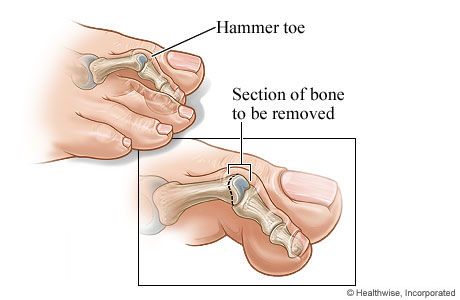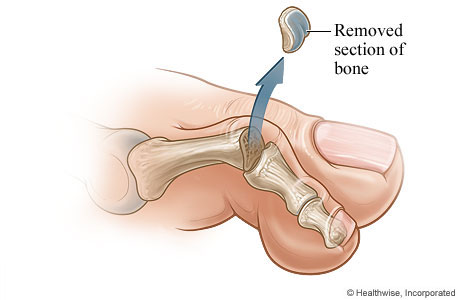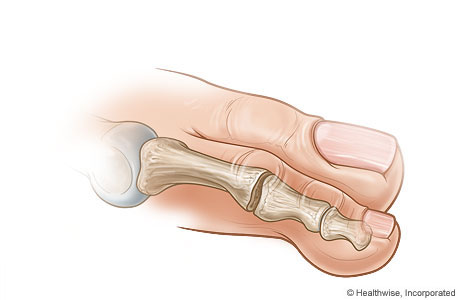Surgery for hammer toe: Overview
Hammer toe surgery straightens a curled toe that causes problems and does not get better with other treatment. Your doctor will make one or more small cuts on your deformed toe joint. These cuts are called incisions. Your doctor will make them to release the tendons that are holding your toe. Then the doctor may remove pieces of bone. Your toe may be held in place, such as with a pin or wire. The pin or wire may stay in your toe, or it may be removed after about 3 to 6 weeks. Sometimes a pin is placed so that it sticks out the end of your toe. Then it can be removed without another surgery.
Most people can go home right after this surgery. You may be able to go back to your normal routine within 3 to 6 weeks. But it may take longer to recover. You should be able to walk on your toe within a day after surgery. But you may need crutches for a few days.
Phalangeal head resection for hammer toe
Phalangeal head resection for hammer toe: Slide 1

A hammer toe is a toe that bends down toward the floor at the middle toe joint. It usually happens in the second toe. The toe may bend up at the joint where the toe and foot meet, causing the middle toe joint to rise up.
Phalangeal head resection for hammer toe: Slide 2

In a phalangeal head resection for a hammer toe, the surgeon removes a section of the phalangeal bone.
Phalangeal head resection for hammer toe: Slide 3

The surgeon removes the bone section.
Phalangeal head resection for hammer toe: Slide 4

The surgeon straightens the toe.
Phalangeal head resection for hammer toe: Slide 5

The surgeon uses a pin to hold the straightened hammer toe in place.
Phalangeal head resection for hammer toe: Slide 6

After the toe has healed, the surgeon removes the pin, and the straightened hammer toe stays in place.
After surgery for hammer toe: When to call
Call 911 anytime you think you may need emergency care. For example, call if:
- You passed out (lost consciousness).
- You have sudden chest pain and shortness of breath, or you cough up blood.
- You have severe trouble breathing.
Call your doctor now or seek immediate medical care if:
- Your foot or toes are cool or pale or change color.
- You have numbness, tingling, or less feeling in your foot or toe.
- You have pain that does not get better after you take pain medicine.
- You have loose stitches, or your incision comes open.
- Bright red blood has soaked through the bandage over your incision.
- You have signs of infection, such as:
- Increased pain, swelling, warmth, or redness.
- Red streaks leading from the incision.
- Pus draining from the incision.
- Swollen lymph nodes in your neck, armpits, or groin.
- A fever.
Watch closely for any changes in your health, and be sure to contact your doctor if:
- You do not have a bowel movement after taking a laxative.
How do you prepare for hammer toe surgery?
Surgery can be stressful. This information will help you understand what you can expect. And it will help you safely prepare for surgery.
Preparing for surgery
- You may need to shower or bathe with a special soap the night before and the morning of your surgery. The soap contains chlorhexidine. It reduces the amount of bacteria on your skin that could cause an infection after surgery.
- Be sure you have someone to take you home. Anesthesia and pain medicine will make it unsafe for you to drive or get home on your own.
- Understand exactly what surgery is planned, along with the risks, benefits, and other options.
- If you take a medicine that prevents blood clots, your doctor may tell you to stop taking it before your surgery. Or your doctor may tell you to keep taking it. (These medicines include aspirin and other blood thinners.) Make sure that you understand exactly what your doctor wants you to do.
- Tell your doctor ALL the medicines, vitamins, supplements, and herbal remedies you take. Some may increase the risk of problems during your surgery. Your doctor will tell you if you should stop taking any of them before the surgery and how soon to do it.
- Make sure your doctor and the hospital have a copy of your advance directive. If you don’t have one, you may want to prepare one. It lets others know your health care wishes. It’s a good thing to have before any type of surgery or procedure.
How can you care for yourself after surgery for hammer toe?
Activity
- Rest when you feel tired. Getting enough sleep will help you recover.
- Try to walk each day if you are able. Start by walking a little more than you did the day before. Bit by bit, increase the amount you walk. Walking boosts blood flow and helps prevent pneumonia and constipation.
- It may be as long as 4 to 6 weeks before you can drive. Ask your doctor when you can drive again.
- You may shower, unless your doctor tells you not to. Keep the bandage dry. If the bandage has been removed, you can wash the area with plain warm water. Pat the area dry.
- You will probably need to take at least 1 to 4 weeks off work, depending on your job. It will be 3 to 6 weeks or longer before you can stand or walk for long periods.
Diet
- You can eat your normal diet. If your stomach is upset, try bland, low-fat foods like plain rice, broiled chicken, toast, and yogurt.
- You may notice that your bowel movements are not regular right after your surgery. This is common. Try to avoid constipation and straining with bowel movements. You may want to take a fiber supplement every day. If you have not had a bowel movement after a couple of days, ask your doctor about taking a mild laxative.
Medicines
- Your doctor will tell you if and when you can restart your medicines. You also will be given instructions about taking any new medicines.
- If you stopped taking aspirin or some other blood thinner, your doctor will tell you when to start taking it again.
- Be safe with medicines. Take pain medicines exactly as directed.
- If the doctor gave you a prescription medicine for pain, take it as prescribed.
- If you are not taking a prescription pain medicine, ask your doctor if you can take an over-the-counter medicine.
- If your doctor prescribed antibiotics, take them as directed. Do not stop taking them just because you feel better. You need to take the full course of antibiotics.
- If you think your pain medicine is making you sick to your stomach:
- Take your medicine after meals (unless your doctor has told you not to).
- Ask your doctor for a different pain medicine.
Incision care
- You will leave the hospital with bandages holding your toe in the correct position. Your doctor will probably remove the bandages after several days. Or your doctor may have you remove your bandages at home. Do not touch the surgery area. Keep it dry.
- Do not soak your foot until your doctor says it is okay.
Ice and elevation
- For pain and swelling, put ice or a cold pack on your foot for 10 to 20 minutes each hour. Put a thin cloth between the ice and your skin.
- Prop up your foot and leg on a pillow when you ice it or anytime you sit or lie down during the next 3 days. Try to keep it above the level of your heart. This will help reduce swelling.
©2011-2025 Healthwise, Incorporated
